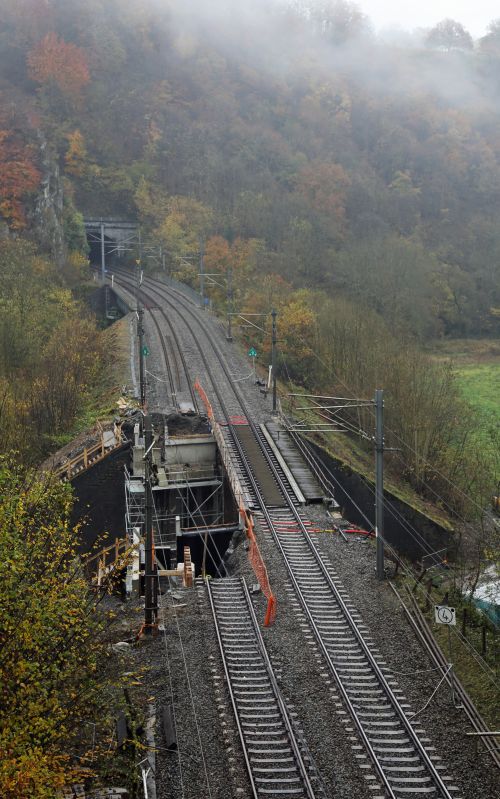Introduction
Documentation
Syntax
|
|
| Documentation
|
state of (a part of) the functional infrastructure regarding its availability and usability
|
| Subschema
|
infrastructure
|
| Parents*
|
infrastructureStates
|
| Children
|
elementState (0..*), name (0..*), validityTime (0..*)
|
Attributes:
- value: railway infrastructure functional state, e.g. "operational" (optional;
xs:string; patterns: other:w{2,})
- Possible values:
- closed: The element is no longer available, removed, dismantled, or no longer exists. Planning, construction or commissioning activities are absolutely necessary for recommissioning.
- conceptual: The construction or commissioning of the element is planned for the medium or long term. However, there are still no concrete (planning) activities for the construction of the element beyond the preliminary planning and cost estimation.
- disabled: The element is currently not usable, switched off or deactivated and therefore cannot be used regularly. However, it can be put back into operation at short notice without further construction, acceptance or approval activities.
- operational: The element is operational and can be used regularly.
- planned: The construction or commissioning of the element is planned concretely and at short notice or concrete planning activities for the construction take place, e.g. design, approval or implementation planning, cost calculation, award of contracts. It is not normally possible to use the element.,
- id: unique identifier (obligatory;
xs:string; patterns: (urn:uuid:)?[0-9a-fA-F]{8}-[0-9a-fA-F]{4}-[0-9a-fA-F]{4}-[0-9a-fA-F]{4}-[0-9a-fA-F]{12}|{[0-9a-fA-F]{8}-[0-9a-fA-F]{4}-[0-9a-fA-F]{4}-[0-9a-fA-F]{4}-[0-9a-fA-F]{12}}); compare: Dev:Identities
|
*Notice:
Elements may have different parent elements. As a consequence they may be used in different contexts.
Please, consider this as well as a user of this wiki as when developing this documentation further.
Aspects that are only relevant with respect to one of several parents should be explained exclusively in the documentation of the respective parent element.
|
|
|
| Documentation
|
state of (a part of) the functional infrastructure regarding its availability and usability
|
| Subschema
|
infrastructure
|
| Parents*
|
infrastructureStates
|
| Children
|
any (0..*), elementState (0..*), name (0..*), validityTime (0..*)
|
Attributes:
- value: railway infrastructure functional state, e.g. "operational" (optional;
xs:string; patterns: other:w{2,})
- Possible values:
- disabled: The element is currently not usable, switched off or deactivated and therefore cannot be used regularly. However, it can be put back into operation at short notice without further construction, acceptance or approval activities.
- closed: The element is no longer available, removed, dismantled, or no longer exists. Planning, construction or commissioning activities are absolutely necessary for recommissioning.
- operational: The element is operational and can be used regularly.
- conceptual: The construction or commissioning of the element is planned for the medium or long term. However, there are still no concrete (planning) activities for the construction of the element beyond the preliminary planning and cost estimation.
- planned: The construction or commissioning of the element is planned concretely and at short notice or concrete planning activities for the construction take place, e.g. design, approval or implementation planning, cost calculation, award of contracts. It is not normally possible to use the element.,
- id: unique identifier (optional;
xs:ID; patterns: (urn:uuid:)?[0-9a-fA-F]{8}-[0-9a-fA-F]{4}-[0-9a-fA-F]{4}-[0-9a-fA-F]{4}-[0-9a-fA-F]{12}|{[0-9a-fA-F]{8}-[0-9a-fA-F]{4}-[0-9a-fA-F]{4}-[0-9a-fA-F]{4}-[0-9a-fA-F]{12}}); compare: Dev:Identities
|
*Notice:
Elements may have different parent elements. As a consequence they may be used in different contexts.
Please, consider this as well as a user of this wiki as when developing this documentation further.
Aspects that are only relevant with respect to one of several parents should be explained exclusively in the documentation of the respective parent element.
|
Changes 3.1→3.2
The children have changed.
The attributes have been changed.
Semantics
Best Practice / Examples
<infrastructureState id="xxx" value="operational">
<elementState id="yyy" refersToElement="aaa" value="closed" />
<elementState id="zzz" refersToElement="bbb" value="closed" />
<elementState id="jjj" refersToElement="ccc" value="closed" />
</infrastructureState>
Bad Practice
<infrastructureState id="xxx" value="closed">
<elementState id="yyy" refersToElement="aaa" value="closed" />
<elementState id="zzz" refersToElement="bbb" value="closed" />
<elementState id="jjj" refersToElement="ccc" value="closed" />
</infrastructureState>
Additional Information
Notes
Open Issues
